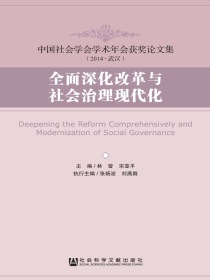编辑推荐
中国经济面临调整,积极开放,为全球发展做贡献,打造经济升级版。
内容简介
中国经济有自身发展的规律,但同时又必然受到世界经济周期性变化的影响。当前,世界经济进入技术创新拓展期、全球化红利递减期和增长模式调整期,中国原有的依附于全球失衡的增长模式、全球化红利的分配模式以及与世界既定分工格局相协调的产业模式都必须作出相应的调整。中国共产党的十八大提出要全面提高开放型经济水平,中国国家主席习近平也多次强调,要更好地统筹国内国际两个大局,坚持开放的发展、合作的发展、共赢的发展,以更加积极的姿态参与国际事务,共同应对全球性的挑战,努力为全球发展作出贡献。当前,中国全面深化改革的号角已经吹响,中国将对经济转型的方向、路径、速度以及目标进行科学规划和演化调整,从而在更大范围、更宽领域、更深层次上提高开放型经济水平,打造中国经济升级版,最终实现中华民族伟大复兴的“中国梦”。本书通过国际社会看得懂的语言和逻辑,探讨当前世界经济格局下中国的进一步改革,向海外读者和国际社会展现中国作为一个负责任的大国建立和谐世界经济的意愿与抱负。
作者简介
黄卫平,中国人民大学教授,博士生导师。主要研究方向为世界经济,经济发展,国际贸易金融与投资,亚太地区经济合作,中国改革与开放。代表作有《亚洲经济中的龙》《走向全球化》。$$$$$黄卫平,经济学博士。1951年生于北京,1968年赴黑龙江生产建设兵团劳动.1978年入中国人民大学世界经济专业本科和研究生学习,1985年赴欧留学。回国后在中国人民大学任教.曾经作为富布赖特高级学者在美国斯坦福大学做研究。现为中国人民大学经济学院教授,国内外数家高校兼职和客座教授,并任国家教育部普通高校本科教学评估委员会委员,中国社会科学院高评委员会(国际片)成员,国务院体改委高评委委员,中国社会科学院美国所、亚太所学术委员会委员,中国世界经济学会、美国经济学会以及中国国际贸易学会常务理事,中国国际金融学会、欧盟经济研究会理事,中美经济学教育交流委员会执行主任,太平洋经济合作中国委员会委员,国务院特殊津贴获得者。若干上市公司独立董事。
曾任北京市政府顾问团成员、教育部经济学科教学指导委员会委员,美国罗兰投资公司、美国信安金融集团北京代表处、亚洲开发银行项目顾问。
代表作:《GATT与走向开放的中国经济》(主编,1994)、《亚洲经济中的龙》(合著,1998)、《走向全球化》(合著,2000)等。学术成果曾多次获奖,主要研究方向为国际经济与商务、经济发展等。
王洪斌,2004年毕业于吉林大学,获经济学硕士学位。2007年考入中国人民大学经济学院攻读博士学位,师从黄卫平教授,主要从事国际贸易、国际金融方面研究。现执教温州大学。
陈秋云,工学士、经济学硕士,中国人民大学经济学院博士生,师从黄卫平教授,主要从事国际经济与贸易学研究。曾在企业从事国内外市场研究工作,并在江西财经大学担任国际贸易教学工作。主持、参与多项省部级课题研究,公开发表学术论文十余篇。现执教九江学院。
宋晓恒,国家首批理财规划师、国家理财规划师考试辅导专家。中国人民大学经济学院博士生,师从黄卫平教授。具有多年大学执教经验,在投资规划、综合理财规划等专业领域有深入研究,长期为境内银行及金融机构提供理财咨询和培训,深受学员欢迎。
胡玫,女,中国人民大学经济学院博士生,师从黄卫平教授,主要从事国际经济合作方面研究。现执教山西财经大学。在国内公开刊物上发表论文十余篇,著有《国际经贸组织研究》。$$$$$黄卫平经济学博士。1951年生于北京,1968年赴黑龙江生产建设兵团劳动,1978年入中国人民大学世界经济专业本科和研究生学习,1985年赴欧留学。回国后在中国人民大学任教,曾经作为富布赖特高级学者在美国斯坦福大学做研究。现为中国人民大学经济学院教授,国内外数学高校兼职和客座教授,并任国家教育部普通高校本科教学评估委员会委员,中国社会科学院高评委员会(国际片)成员,国务院改革高评委委员,中国社会科学院美国所、亚太所学术委员会委员,中国社会经济学会、美国经济学会以及中国国际贸易学会常务理事,中国国际金融学会、欧盟经济研究会理事,中美经济学教育交流委员会执行主任,太平洋经济合作中国委员会委员,国务院特殊津贴获得者,若干上市公司独立董事。
曾任北京市政府顾问团成员、教育部经济学科教学指导委员会委员、美国罗兰投资公司、美国信安金融集团北京代表处、亚洲开发银行项目顾问。$$$$$黄卫平,经济学博士,中国人民大学国际经济系教授,博士生导师,教育部经济学教学指导委员会委员,中国社会科学院高评委员会委员,中国世界经济学会、中国国际贸易学会等学会的理事或常务理事,太平洋经济合作委员会国际顾问组成员,国务院特殊津贴获得者。研究方向为国际经济、经济发展等。主要代表作有:《国际经济学教程》《中国经济发展理论与实践研究》《发展经济学》(第2版)《走向全球化》等。$$$$$黄卫平,中国人民大学经济学院教授,博士生导师$$$$$黄卫平,男,经济学博士,1951年出生于北京,1968年赴黑龙江生产建设兵团劳动,1978年入中国人民大学世界经济专业本科和研究生学习,1985年赴欧留学,回国后在中国人民大学任教,曾经作为富布赖特高级学者在美国斯坦福大学作研究,长期担任中国人民大学经济学院院长,现为中国人民大学教授、博士生导师、教育部经济学科教学指导委员会成员、教育部本专科教学评估委员会委员、中国社会科学院学术委员会委员、国务院体改委学术委员会委员、中国世界经济学会、中国国际贸易学会会、美国经济学会、欧盟经济研究会的常务理事、中美经济学教育交流委员会执行主任,国务院特殊津贴获得者。
曾为北京市顾问团成员、美国罗兰投资公司、美国信安金融集团北京代表处、亚洲开发银行项目顾问。代表作为《GATT与走向开放的中国经济》(1994年,主编)、《亚洲经济中的龙》(1998年,合著)、《走向全球化》(2000年,合著)等,主要讲授国际经济学、商务
章节目录
版权信息
About the Author
Synopsis
Chapter 1 The World Economic Setup With Reform
"Imbalance" and "Re-balance" of World Economic Development
This "imbalance" is not that "imbalance"?
"Phenomenon" =/ "original characteristics"?
Suffering from "influenza" but let others take medicine
Excuse 1: There is serious imbalance in China-US trade
Excuse 2:RMB should drastically revalue in order to re-balance the world economy
Excuse 3: China should increase its import of US products
Who should bear the cost of global imbalance?
"Changing" and "New Normal" on the World Economic Scene
Cooperation in the context of competition? Or competition in the context of cooperation?
"Happy alone" or "happy together"?
"Multi-polarization" or "non-polarization"?
The "Intrigue" and "Love" in the World Economic Governance
"Crime" and "punishment" of global governance
Governance mechanism: can we perform "face changing"?
Trade mechanism: are"barriers" necessary?
Financial mechanism: trusting the"big brother"?
Gaming in governance: China and America's "give" and "take"
US: still the "locomotive"
China: willing to be a"stabilizer"
Future: Realizing the objective of"inclusiveness"
Chapter 2 Uncertain Prospects of the International Economy
The"Inside" and "Outside" of Policy Adjustments of Developed Countries
"Reverse operation" of US financial policies
The"after effects" of the European debt crisis
Deceleration of Abe's Arrow
De-leveraging in Different Countries: "Cold" and "Hot"
Financial"alleviating burden" of developed economies
Newly Emerging Economies"on the Way"
The "Perpendicular" and "Horizontal" of New Currency Alliances
New "Fiscal Pact" of the European Union
"Atlantic System" and C6 Club
"Rise" and "Decline" of Trade Arrangements
Renewed prevalence of regional trade arrangements
US's new trade map
Response by newly emerging economies
"High-speed" and "Slow-speed" Development of Newly Emerging Economies
Growth predicament for newly emerging economies
Policy "dilemma" for newly emerging economies
Finding growth motivation
"Loss of energy" in the development locomotive
"Differences" and "Similarities" in the Changes in the Chinese Economy and the World Economy
"Isotropism" in China's volatility and the world economy
"Synchronicity" of the key indicators and the world trends
"Coupling" of Chinese and US economic cycles
The "cyclicity" of the world economy structure
Chapter 3 China's Coordinate in the World Economy
"Active" and "Passive" in the World Factory
"Flying Geese Model" and "Pass the Parcel" (Flower Transfer on Drumming Beat) in international industry transfer
"Wintelism" and the "magnetic effect" with the global production network
The "Strong Point" and "Weak Point" of Development Models
Small cost, large scale: China's well-endowed "kill secret"
Low profit, large market share: market formula for China's manufacturing industry
"Dream" and "Reality" of Industry Upgrade
The "growth" and "anxieties" of China's development
"Objectives" and "conditions" of market orientation
"Orientation" and "regulations" of structural adjustment
Opponent and strategy of international division of labor
"Elasticity" and "choices" in export products
"Disadvantage" and "advantage" in the endowment of factors
"Distribution" vs "growth" in social welfare
"Flow" and "ending" of global resources
Chapter 4 Difficulties and Focus in China's Economic Development
"Internal Cause" and "External Cause" in the Development Bottleneck
Three waves of bad mouthing China
The first badmouthing: China's society will collapse
The second badmouthing: theory of collapse of the Chinese economy
The third badmouthing: China will completely collapse
The four choices of China's economy
The first turning point: class struggle vs economic construction
The second turning point: defending of peaceful evolution vs developing economy
The third turning point: hesitation vs determination to enter into the WTO
The fourth turning point: government-oriented vs market-driven
Five internal causes in the development bottleneck
First bottleneck: the conflict of supply and demand
Second bottleneck: energy bottleneck
Third bottleneck: environmental bottleneck
Fourth bottleneck: food grain bottleneck
Fifth bottleneck: regional imbalance
Six external causes for the development bottleneck
First bottleneck: China's overseas acquisitions failed as a "going out" attempt
Second bottleneck: China's external trade is facing TPP blockage
Third bottleneck:export of China's high-tech products are constrained
Fourth bottleneck: China's overseas energy and import channels are in a state of "non fortification"
Fifth bottleneck: China's economy is facing the impact of the financial crisis
Bottleneck 6: geo-political conflicts influence China's economic development
The "Hot Spot" and "Bright Spot" in the Development
Consumption—from acceleration to stalling
The rise and fall of mass consumption hot spots has become history
The troika stalls and internal demand remains weak
Indicator 1: people's consumption as a percentage of the GDP is lower than the global average
Indicator 2: people's savings as a percentage of GDP is higher than the global average
Innovation: from passionate to lethargic
The science and education system calls for reform
Defects in the enterprise innovation system
The "Phenomenon" and "Nature" of Main Prices
High oil prices control the production costs of enterprises
High property prices control the people's consumer costs
The conspiracy behind the low-cost plot in the manufacturing industry
"Addition" and "Subtraction" in Structural Adjustment
"Subtraction" is to eliminate the backward production capacity
The "Curse" and "Opportunity" of Economic Growth
The probability of the "Lawrence Spell" coming true
How to avoid the "middle income trap"
Chapter 5 Dialectics of China's Comprehensive Deepening of Reform
"Macro View" and "Micro View" of the Economic Structure
Accurately select the macro direction of economic transformation
Let the market play a decisive role in resource allocation
Boosting economic vitality of various kinds of ownership systems
Value the micro-economic basis of macro-economic regulation
Making the best use of the market's "invisible hand"
"Precision" and "Vagueness" in Policy Choice
Objectives and tasks of China's development
Measures and means in China's development
"Return" and "Forward" in the Direction of Transformation
System innovation drives "forward"
Break the industry monopoly and drive the reform of the state-owned enterprises
Protect intellectual property and encourage innovation
Monetary policy regains prudence
Top priority in financial reform
"Sustainability" and "Un-sustainability" of Development Issues
The "two synchronicities" that break the vicious circle
Anti-corruption paves the way for system reform
"Progress" and "Synergy" in Wealth Creation
The path from "being wealthy first" to "sharing wealth"
China practices three major wealth creation theories
From Pareto optimality to real fairness
Drive the shift of social structure from dumbbell-type to olive-type
Chapter 6 Conclusions and Forecasts
"Competition" and "Cooperation" in the Global Pattern
"Change" and "Removal" in China's Development
References
全面深化改革与世界经济(英文版)是2015年由中国人民大学出版社出版,作者黄卫平。
得书感谢您对《全面深化改革与世界经济(英文版)》关注和支持,如本书内容有不良信息或侵权等情形的,请联系本网站。

















